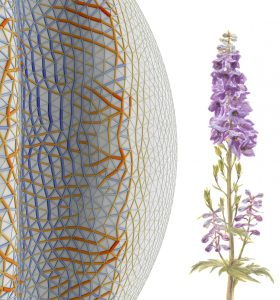| Pollen grains carry male plant genetic material, encapsulated in a hard protective shell containing flexible, soft regions—apertures. When pollen grains leave the protective environment of the anther, they are exposed to the often harsh external environment and start to lose water. In order to protect their contents from dehydration, the grains fold into themselves, guided by the mechanical design of the grain. Anže Božič and Antonio Šiber have investigated how pollen folding pathways are governed both by the interplay between the elastic properties of the hard and soft regions of the pollen shell and by the aperture shape, number, and size. In their publication in Proceedings of the National Academy of Sciences, they have delineated the regions of mechanical parameters of the pollen grain which lead to complete closure of all apertures, thus reducing water loss and presenting evolutionary viable solutions to the infolding problem. In particular, phase diagrams of pollen folding pathways indicate that an increase in the number of apertures leads to a reduction of the region of elastic parameters where the apertures close in a regular fashion, providing an additional perspective to the yet unexplained prevalence of triaperturate pollen grains in eudicots. |  |
| Publication: Božič. A. and Šiber, A.: Mechanical design of apertures and the infolding of pollen grain. Proc. Natl. Acad. Sci. USA (2020) |

